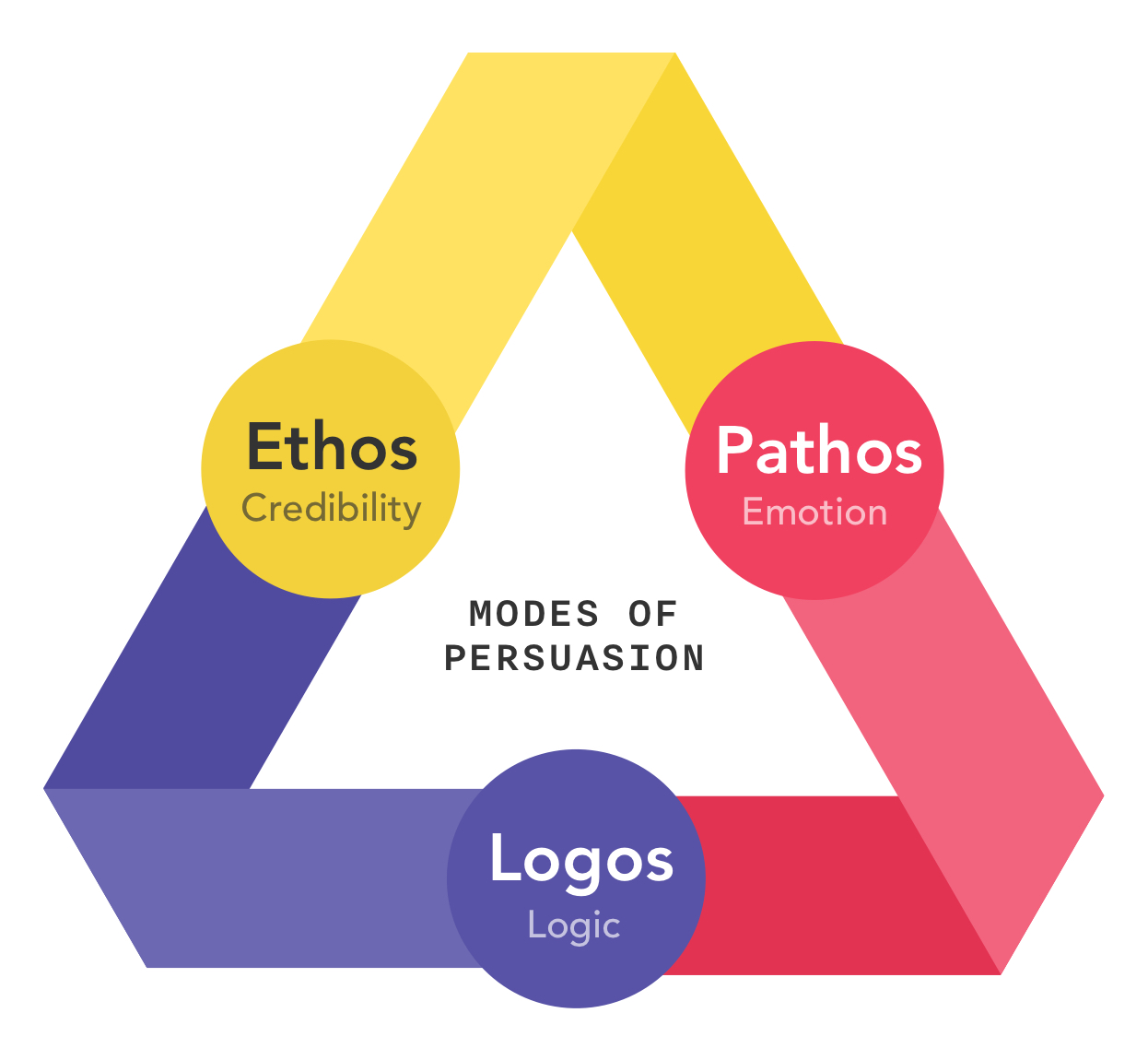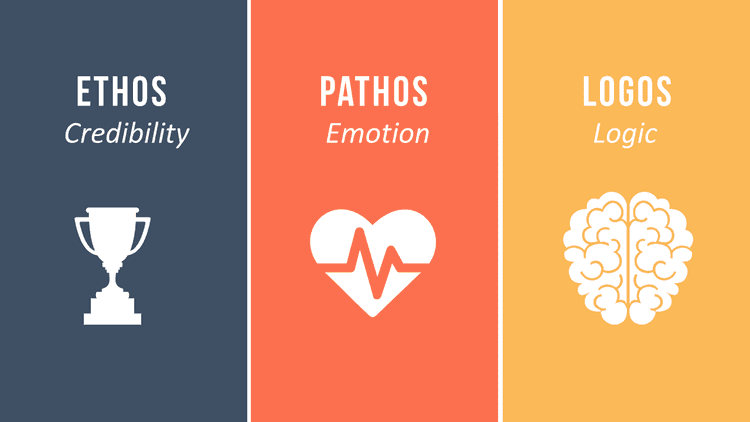
Introduction
In the realm of effective writing, mastering the concepts of ethos, pathos, and logos is essential for achieving impactful and persuasive communication. A skilled writer understands the significance of employing these rhetorical techniques to engage and convince their audience.
Why mastering ethos, pathos, and logos is crucial for effective writing
Ethos, pathos, and logos are three modes of persuasion that Aristotle identified in ancient Greece. Each of these techniques appeals to different aspects of human psychology and can be effectively used to convey messages and influence opinions.
-
Ethos: This mode relies on establishing the credibility and trustworthiness of the writer. Writers can establish their credibility and persuade their audience by appearing knowledgeable, reputable, and unbiased.
-
Pathos: Pathos taps into the emotions of the audience. By evoking empathy, sympathy, or other emotional responses, writers can create a powerful connection and generate a heartfelt response from their readers. This emotional appeal often helps in capturing attention and influencing opinions.
-
Logos: Logos relies on logic, reason, and evidence to persuade the audience. By presenting well-reasoned arguments, facts, data, and logical conclusions, writers can establish the logical validity of their claims and convince their readers through sound reasoning.
Mastering these three persuasion techniques can improve writing effectiveness, capture audience attention, and make a lasting impact. The strategic implementation of ethos, pathos, and logos brings depth, credibility, and persuasiveness to their work, ultimately leading to more successful communication.

Source: hyperbolit.files.wordpress.com
Understanding Ethos
Definition and importance of ethos in writing
Ethos is the persuasive appeal of a writer or speaker based on their credibility, authority, and trustworthiness. It establishes them as a knowledgeable and reliable source of information. In writing, ethos plays a crucial role in gaining the trust and respect of the audience. It helps build a connection and convinces readers to believe in the writer’s message.
The importance of ethos in writing lies in its ability to enhance the writer’s credibility. When readers perceive the writer as credible and trustworthy, they are more likely to be persuaded by their arguments and engage with their content. Ethos brings authority to the writing, making it more persuasive and influential.
Examples of ethos in persuasive writing
Ethos can be demonstrated in various ways in persuasive writing. Here are a few examples:
-
Professional Credentials: Writers may showcase their expertise, qualifications, or professional achievements to establish their credibility on a topic.
-
Personal Experience: Sharing personal experiences and anecdotes can help writers connect with readers emotionally and establish their authenticity.
-
Use of Reliable Sources: Citing reputable sources like scientific studies, expert opinions, and statistics lends credibility to the writer’s arguments.
-
Well-balanced Arguments: Presenting a balanced perspective, acknowledging counterarguments, and addressing them objectively can strengthen the writer’s ethos.
-
Building Trust: Being transparent, honest, and respectful in writing can foster trust with the audience, enhancing the writer’s ethos.
Mastering ethos enables writers to create compelling, trustworthy, and persuasive content that resonates with the readers. By effectively utilizing ethos, writers can build strong connections and gain credibility in their fields.
Harnessing Pathos
Definition and significance of pathos in writing
Pathos is a rhetorical appeal that aims to evoke emotions in the reader or audience. It plays a crucial role in effective writing as it can help create a connection and engage the reader on a deeper level. By appealing to the reader’s emotions, writers can make their message more relatable and persuasive. Pathos is a technique that can make people feel different emotions like happiness, sadness, anger, or empathy. The specific emotion depends on what the writer wants to achieve and the subject they are writing about.
Tips for evoking emotions in your writing
To harness the power of pathos in your writing, consider the following tips:
-
Use vivid imagery: Paint a picture with words to create emotional impact. Describe scenes, characters, or experiences in a way that taps into the reader’s senses and generates a feeling.
-
Tell stories: Narrative writing can be immensely powerful in evoking emotions. Share anecdotes, personal experiences, or relatable stories that resonate with the reader’s emotions.
-
Appeal to shared values: Understand your audience and identify the values they hold dear. Incorporate those values into your writing to create a sense of shared experience and emotional connection.
-
Choose the right words: Select words and phrases that convey the desired emotions. Use descriptive and emotionally charged language to make your writing more impactful.
By effectively harnessing pathos in your writing, you can create a compelling and engaging piece that resonates with your audience on an emotional level. Remember to maintain a balance in your arguments. It is important to effectively use pathos, ethos, and logos to create a strong and convincing argument.

Source: downloads.boords.com
Utilizing Logos
Definition and role of logos in writing
In effective writing, logos refers to the use of logical reasoning and evidence to support and strengthen your arguments. This includes facts, statistics, research findings, and logical explanations that appeal to the reader’s rationality and intellect. By utilizing logos in your writing, you establish credibility, demonstrate a sound understanding of the subject matter, and present a well-structured and logical argument. It helps convince your audience that your ideas are supported by solid evidence and reasoning.
Techniques to strengthen logical reasoning in your writing
-
Research and gather evidence: Conduct thorough research to collect relevant facts, statistics, expert opinions, and case studies that support your argument. Make sure to use credible and authoritative sources.
-
Organize your ideas: Structure your writing logically and coherently. Clearly state your main points and provide supporting evidence for each point.
-
Use logical transitions: Construct clear and logical connections between your ideas. Transition words and phrases such as “therefore,” “in conclusion,” and “because” help guide the reader through your arguments.
-
Avoid logical fallacies: Be mindful of logical fallacies such as circular reasoning, hasty generalizations, and false analogies. These weaken the credibility of your arguments and undermine the logical reasoning.
-
Present counterarguments: Acknowledge and address opposing viewpoints or counterarguments. By doing so, you demonstrate a fair and balanced approach, strengthen your own arguments, and enhance your credibility as a writer.
By effectively utilizing logos in your writing, you can craft persuasive and compelling arguments grounded in logic and evidence. This not makes your writing more convincing andablishes your expertise and credibility on the subject.
Blending Ethos, Pathos, and Logos
Writing effectively requires a strong understanding of the three rhetorical appeals: ethos, pathos, and logos. By effectively blending these appeals, writers can create compelling and persuasive content that resonates with their audience.
Strategies for combining ethos, pathos, and logos in persuasive writing
-
Leverage Ethos: Ethos appeals to the credibility and authority of the writer. To incorporate ethos into your writing, establish your expertise on the topic, cite reliable sources, and present logical arguments supported by evidence.
-
Evoke Pathos: Pathos appeals to the emotions of the audience. To evoke pathos, use storytelling, vivid descriptions, and personal anecdotes that connect with the readers’ emotions and values.
-
Utilize Logos: Logos appeals to the logic and reasoning of the audience. To incorporate logos into your writing, provide statistical data, logical reasoning, and sound arguments that ddemonstrating your claims’ validity-life examples of successful writing that leverages all three appeals
-
Martin Luther King Jr.’s “I Have a Dream” speech: King’s speech exemplifies the effective use of ethos by establishing himself as a credible and passionate leader, evokes pathos by appealing to the emotions and dreams of the audience, and utilizes logos through logical arguments for racial equality.
-
Apple’s “Think Different” campaign: Apple leveraged ethos by showcasing the achievements and credibility of influential individuals, evoked pathos by inspiring viewers with emotional storytelling, and utilized logos through the logical reasoning behind their innovative products.
By blending ethos, pathos, and logos, writers can create persuasive and impactful content that engages their audience and effectively communicates their message.

Source: contenthub-static.grammarly.com
Common Pitfalls to Avoid
Mistakes to steer clear of when applying ethos, pathos, and logos in writing
In the world of persuasive writing, it’s crucial to understand and effectively apply the principles of ethos, pathos, and logos. However, there are common pitfalls that writers should be aware of to ensure the highest level of effectiveness in their work.
One mistake to avoid is relying solely on one of the appeals. Ethos, pathos, and logos are most powerful when used in combination with each other. Focusing solely on one can lead to an imbalance and weaken the overall impact of your writing.
Another pitfall to steer clear of is the misuse of these appeals. Ethos, which establishes credibility and trust, should be supported with accurate and reliable factual information. Pathos, which appeals to emotions, should be used responsibly and tactfully to avoid manipulating or exploiting the readers’ emotions. Lastly, logos, which utilizes logic and reasoning, should be clear and concise, avoiding over-complication or confusion.
How to maintain balance and avoid overusing or misusing these appeals
To maintain balance when using ethos, pathos, and logos, it’s essential to consider your target audience and their specific needs and preferences. Tailor your writing to appeal to their emotions, logic, and credibility in a way that resonates with them.
Additionally, it’s crucial to support your claims with solid evidence and research, ensuring that your arguments are well-founded and logical. Avoid overusing emotional appeals, as this can come across as manipulative. Instead, craft a well-rounded and thoughtful approach that combines all three appeals harmoniously and persuasively.
By avoiding these common pitfalls and striving for balance, writers can master the art of using ethos, pathos, and logos effectively. This will elevate the quality of their writing and increase the likelihood of successfully persuading and engaging their readers.

Source: gamestorming.com
Enhancing Your Writing with Ethos, Pathos, and Logos
When it comes to effective writing, mastering the art of persuasion is crucial. Ethos, pathos, and logos are three rhetorical devices that can greatly enhance your writing and convince your audience.
Practical exercises and activities to improve your skills in ethos, pathos, and logos
-
Developing Ethos: Ethos refers to establishing your credibility and expertise as a writer. To improve your ethos, engage in activities such as researching and citing reliable sources, showcasing your experience, and building a reputation as a trustworthy writer.
-
Harnessing Pathos: Pathos involves tapping into your audience’s emotions to create a connection. Practice using emotional appeals in your writing by telling powerful stories, using vivid imagery, and incorporating personal anecdotes or testimonials.
-
Applying Logos: Logos relies on logical reasoning and evidence to persuade. Sharpen your skills in logos by structuring your arguments logically, presenting reliable data and statistics, and highlighting cause-and-effect relationships.
Tips for incorporating these appeals into different genres of writing
-
Academic Writing: In academic writing, emphasize ethos by supporting your arguments with well-researched and credible sources. Utilize logos to present logical evidence and reasoning. Use pathos sparingly, focusing on the intellectual appeal rather than solely emotional appeals.
-
Business Writing: In business writing, establishing ethos is crucial. Highlight your expertise and credentials. Utilize logos to present data, facts, and logical arguments that support your business proposals. Incorporate pathos strategically to appeal to the emotions and values of your target audience.
-
Creative Writing: In creative writing, pathos plays a significant role in engaging the readers’ emotions. Use descriptive language and imagery to create emotional connections. Ethos and logos can still be used but focus more on evoking emotions and storytelling.
Mastering ethos, pathos, and logos can greatly improve your writing and ability to effectively persuade your audience. Practice incorporating these appeals and tailor them to suit various writing genres for maximum impact.

Examples from Literature and Public Speaking
Examining renowned speeches and literary works that effectively use ethos, pathos, and logos
When it comes to effective writing, mastering the use of ethos, pathos, and logos is essential. Ethos appeals to credibility and trustworthiness, pathos taps into emotions, and logos deals with logic and reasoning. By skillfully incorporating these three elements, writers can create persuasive and impactful content.
Analysis and breakdown of the techniques employed in these pieces
To truly understand and apply ethos, pathos, and logos in writing, examining renowned speeches and literary works as examples is beneficial. By analyzing these pieces, writers can gain insight into the techniques used and how they contribute to the overall effectiveness.
Studying speeches like Martin Luther King Jr.’s “I Have a Dream” and literary works like William Shakespeare’s “Romeo and Juliet” helps writers learn how to use ethos, pathos, and logos to engage the audience and convey a message.
In Martin Luther King Jr.’s speech, ethos is established through his reputation as a civil rights leader and his use of historical references. Pathos is evoked through emotional language and vivid storytelling. And logos is utilized through the logical arguments and statistical evidence presented.
Similarly, in “Romeo and Juliet,” Shakespeare uses ethos to establish credibility through his reputation as a renowned playwright. Pathos is achieved by stirring the readers’ emotions through the tragic love story. And logos is employed through the logical progression and reasoning within the plot.
By studying and analyzing these examples, writers can learn how to effectively integrate ethos, pathos, and logos into their writing, resulting in more persuasive and compelling content.

Ethical Considerations in Persuasive Writing
Exploring the ethical implications of using ethos, pathos, and logos
Mastering the art of persuasive writing requires a deep understanding of the ethical implications behind the use of ethos, pathos, and logos. These persuasive techniques appeal to different emotions and reasoning to influence the audience. However, it is crucial to utilize them responsibly and ethically to maintain credibility and respect.
Using ethos, which appeals to credibility and ethics, involves building trust with the audience by demonstrating expertise and integrity. However, ensuring the information presented is accurate and supported by reliable sources is essential. Misrepresenting facts or exaggerating claims can lead to a loss of trust and credibility.
Pathos, the appeal to emotions, can be a powerful tool for persuasion. However, it is important to use emotional appeals ethically by avoiding manipulative tactics or exploiting vulnerable emotions. Instead, focus on genuine and relatable experiences that evoke empathy and connection.
Logos, the appeal to reason and logic, relies on presenting evidence, facts, and logical arguments. It is crucial to use accurate data and logical reasoning to support claims. Misrepresenting information or using fallacious arguments can undermine the credibility of the persuasive message.
Guidelines for responsible and ethical persuasive writing
-
Research and accuracy: Ensure the information and evidence presented in your persuasive writing is accurate, reliable, and supported by credible sources.
-
Honesty and integrity: Be honest and transparent about your intentions and avoid misleading or deceptive tactics.
-
Respectful persuasion: Respecting the audience’s autonomy and choices is vital. Avoid manipulating or coercing individuals into making decisions against their interests.
-
Empathy and empathy: Understand the emotions and perspectives of the audience and address their concerns and needs with compassion and understanding.
-
Consider diverse perspectives: Acknowledge and respect diverse viewpoints, even if they differ from your own. Engage in respectful dialogue and avoid personal attacks or derogatory language.
By following these guidelines, you can harness the power of ethos, pathos, and logos in persuasive writing while maintaining ethical standards and integrity.

Conclusion
Mastering ethos, pathos, and logos is crucial for effective writing. By understanding and utilizing these persuasive techniques, writers can appeal to their audience’s logic, emotions, and credibility to convey their message effectively.
Recap of the importance of mastering ethos, pathos, and logos in effective writing
Ethos, pathos, and logos are three rhetorical appeals that hold immense importance in effective writing:
-
Ethos: Ethos refers to the writer’s credibility and trustworthiness. By establishing a strong ethos, writers can build authority and convince their audience to trust and believe in their argument.
-
Pathos: Pathos appeals to the emotions of the readers. It helps writers connect with their audience by evoking feelings such as empathy, sympathy, or passion. By appealing to emotions, writers can create a deeper impact and resonate with their readers.
-
Logos: Logos focuses on logical reasoning and evidence. By presenting well-reasoned arguments, backed by facts, data, and examples, writers can establish credibility and persuade their readers based on rational thinking.
Final thoughts and encouragement to apply these skills in your own writing endeavors
Mastering ethos, pathos, and logos is an ongoing process that requires practice and refinement. In your own writing endeavors, remember to:
- Balance: Strive for a balance between the three appeals, ensuring that your writing appeals to both logic and emotions, while establishing credibility.
- Know your audience: Understand your target audience’s needs, values, and beliefs and tailor your writing accordingly.
- Use evidence: Support your arguments with credible evidence and logical reasoning to enhance their persuasiveness.
- Revise and edit: Regularly review and refine your writing, paying attention to the effective use of ethos, pathos, and logos.
To become a better writer, continuously practice and improve your skills. This will help you effectively communicate your ideas and engage your readers.




